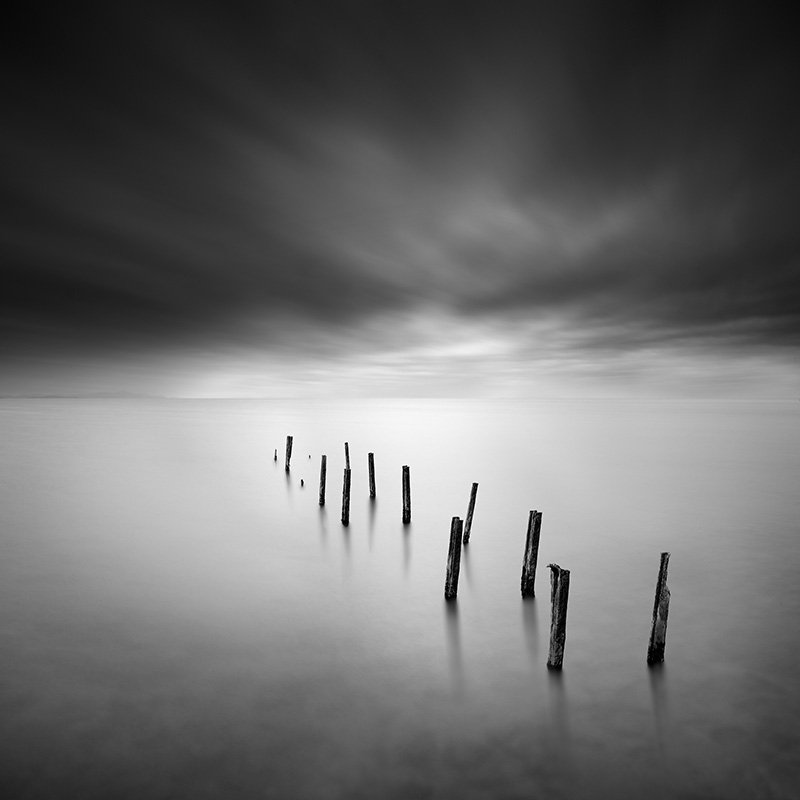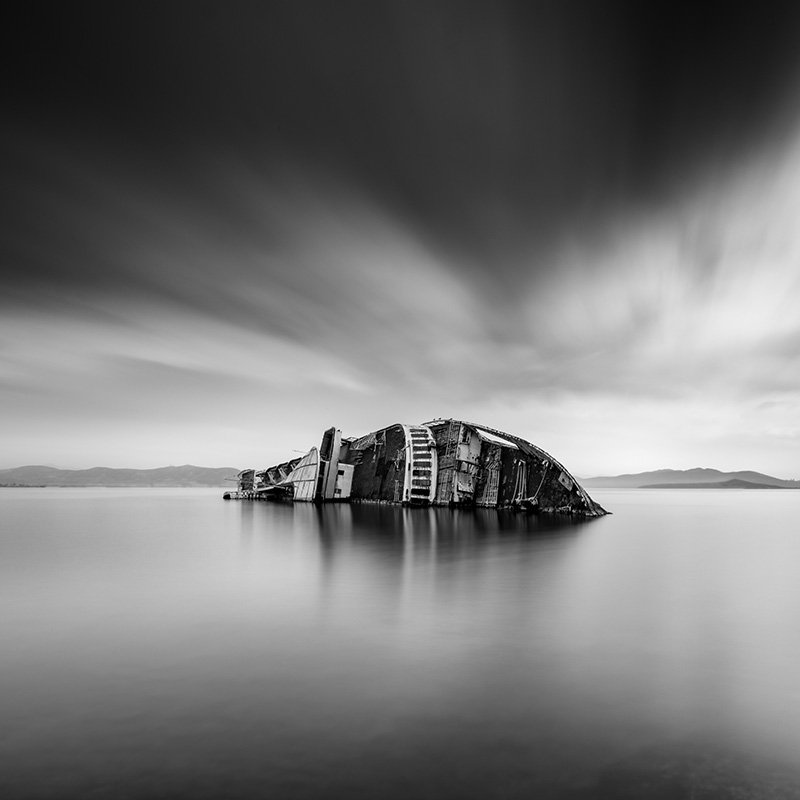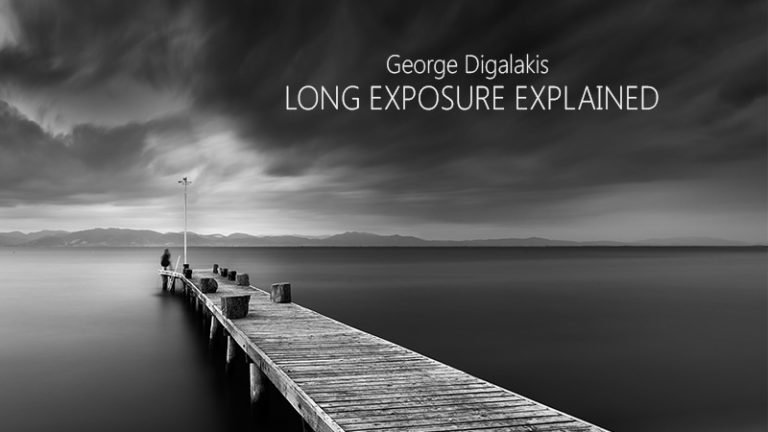
The term Long Exposure (LEP) or Slow Shutter Photography refers to a technique that involves longer shooting times than those indicated by the camera’s photometer and allows the photographer to blur the moving objects, while sharply capturing the stationary elements.
Examples of this type of photography are moving people in an urban environment and seascapes depicting piers or rocks. In the 1st case the background appears sharp, while the theme is blurred. The opposite is true in the 2nd case where the waves appear smoothened and the clouds form broad bands. Other examples are the creation of paths of bright moving objects – e.g. car lights or the trails of the stars.
With LE we can capture an element that is not possible with conventional photography: the dimension of time.
There is no certain definition of what «long exposure» is or how long the shooting must be. Since our intention is to show the effect of passing time it must include one or more moving objects. The “Motion Effect” can be achieved with a shutter speed of a few seconds for quickly moving objects like a train. On the contrary, capturing the moving clouds, smoothing the sea surface or showing the star trails often needs exposure times from several minutes to hours.
The easiest way to achieve longer exposure times is to shoot at low light conditions e.g. during the night. For daylight conditions one or more Neutral Density Filters (ND filters)have to be used.
A photographer will quickly face some problems in this type of photography, especially when using ND filters, as many of the automatic functions of the camera are inaccessible. Bellow you’ll find a list of 16 tips and suggestions for a successful LE image, which I have gathered during my journey in the beautiful world of Long Exposure Landscape Photography.

- Weather: Check the weather forecast. If there are no clouds then find something more interesting to do. A cloudy sky along with strong winds (ideally just before or after a storm – not so strong though :)) are ideal conditions for long exposure photography. For me, the best time is early in the morning or just before sunset, when the sun is low, increasing cloud contrast.
- Scouting: If there is an opportunity, scout the location before, especially if you’re going to shoot in low light conditions. That means finding where you’re going to place your camera and thinking about the possible compositions. A LE capture takes a lot of time, and a good preparation will allow for more shots, once in the location.
- Equipment: Prepare your equipment before you set off. Clean your lenses and filters, check the batteries etc. See more about preparation here.
4. Tripod: A high quality, sturdy tripod is a must. Make sure to put its legs on firm ground, keep the centre column closed and secure (or even better remove) the camera’s strap to avoid shaking during the exposure. Some people suggest placing a small bag either on the camera or hanging beneath it, for additional stabilization.
While this is not something I do, it’s not a bad idea especially when very strong winds are forecasted.
- Remote Shutter Release: Pressing the shutter button with your finger is not advised, as it can reduce the sharpness of your main object. A remote shutter release is the best solution. Look for a camera with an embedded infrared remote control as my previous camera (Nikon D7000) had.
- Filter holder: Some extra wide lenses, often used in this type of photography, don’t accept round, screw-on filters, as is the case with my Nikon 14-24mm. In this case you have to use square filters, adjusted in front of the lenses with the help of a filter holder. I find it more convenient to put the filter holder, along with the ND filters, in a later stage, just before pressing the shutter.
- Manual Mode: Set your camera to manual or apperture priority mode. Auto mode simply doesn’t work here.
- ISO: Set a low ISO value. Except from the obvious advantage of producing less noise, it allows for longer shutter speeds.
- Compose and Focus: This must be done before you put the filters, as it is nearly impossible for most cameras to see through the viewfinder or focus with the filters on. When ready put the camera in manual focus mode. Given the time and effort for such an exposure it is very frustrating to have a bad composition or poor focus.
- Set the exposure: It’strue that the best aperture value for most cameras is around f/8 to f/11, but I often work with smaller apertures (f/22 or even more) in order to achieve longer shooting times. I suggest using the optimal value for your camera when shooting in low light conditions. In this case a small apperture is not really necessary. Shooting in day light, however, requiresan extra small aperture in order to achieve longer shutter speeds.

- Test shot: Make a test shot with the set exposure and study the camera’s histogram. If you’re sattisfied with the result note or just remember the shutter speed shown by the photometer.
- Add the ND filters: This is the most demanding step. You have to calculate what filter you’ll need, based on the desirable exposure time. For example if the test shot was 1/30th of a second and you want to achieve a 4 min shutter speed you will need to add 13 stops. That means a 500ND filter (9 stops) + a 16ND filter (4 stops), or any other combination, depending on the filters you have. Of course there is no need to remember all the possible combinations or make complicated calculations. You can find special conversion tables on the web as the one shown here
- Select bulb mode: For exposure times over 30 sec (or 60sec for some cameras) a remote control is needed, so the camera has to be on bulb mode.
- Viewfinder: I suggest closing (or covering) the viewfinder in order to prevent light entering the camera during the exposure, especially if there is direct sunlight.
- Noise Reduction: Long exposure introduces noise in the form of hot pixels – small colored spots on your image. That means a lot of post processing time and effort to remove them. Most cameras have a long exposure noise reduction feature. Using this mode results in doubling the time of the exposure. After the end of the actual exposure, the camera takes a second exposure, equal in time to the first one, in order to define the hot spots and subtract them from yourrealexposure. There are opposing views among the photographers about the use of this feature. I find it useful and always use it.
- A final tip before pressing the Shutter Button: I usually use an additional graduated filter when the sky is relatively light. Using a 2-stop graduated filter adds 1 more stop to your exposure time calculations. Additionally the conversion tables are inaccurate when the shutter speed is longer than 2-3 minutes. Finally, in sunset, the light conditions are changing rapidly. From my experience, in longer exposure times an additional 50-75% must be added to the calculated exposure.
If all this seems too complicated and despite the large amount of steps described above, I want to assure you that after some practice they can be performed without much thinking. While Long Exposure Photography requires more planning, time and effort, the results will definitely reward you.
You can read more articles about B&W Photography on my blog: “Inspirations”
Long Exposure Explained
By George Digalakis– (c) Copyright 2017 MinimalismMag.com / George Digalakis



